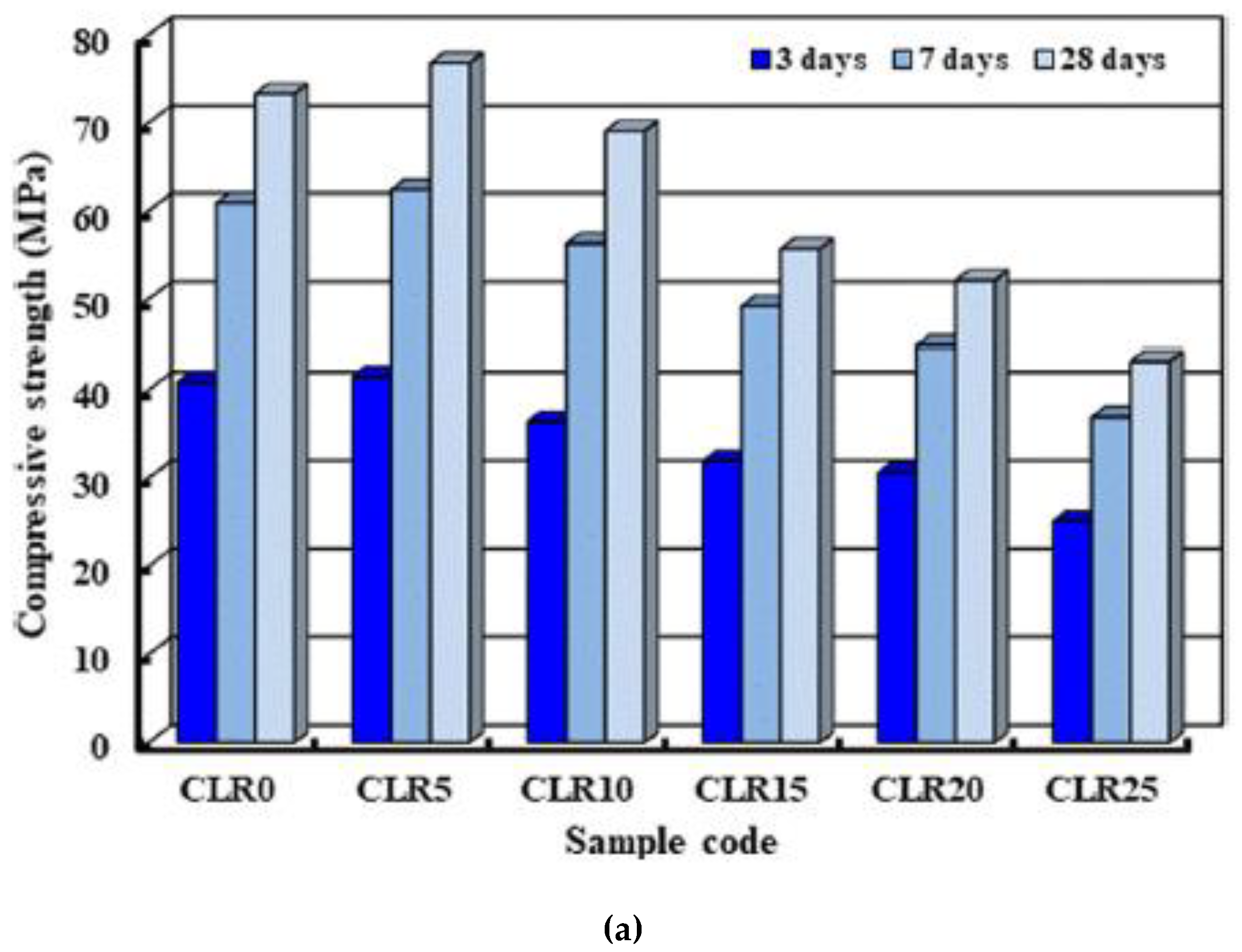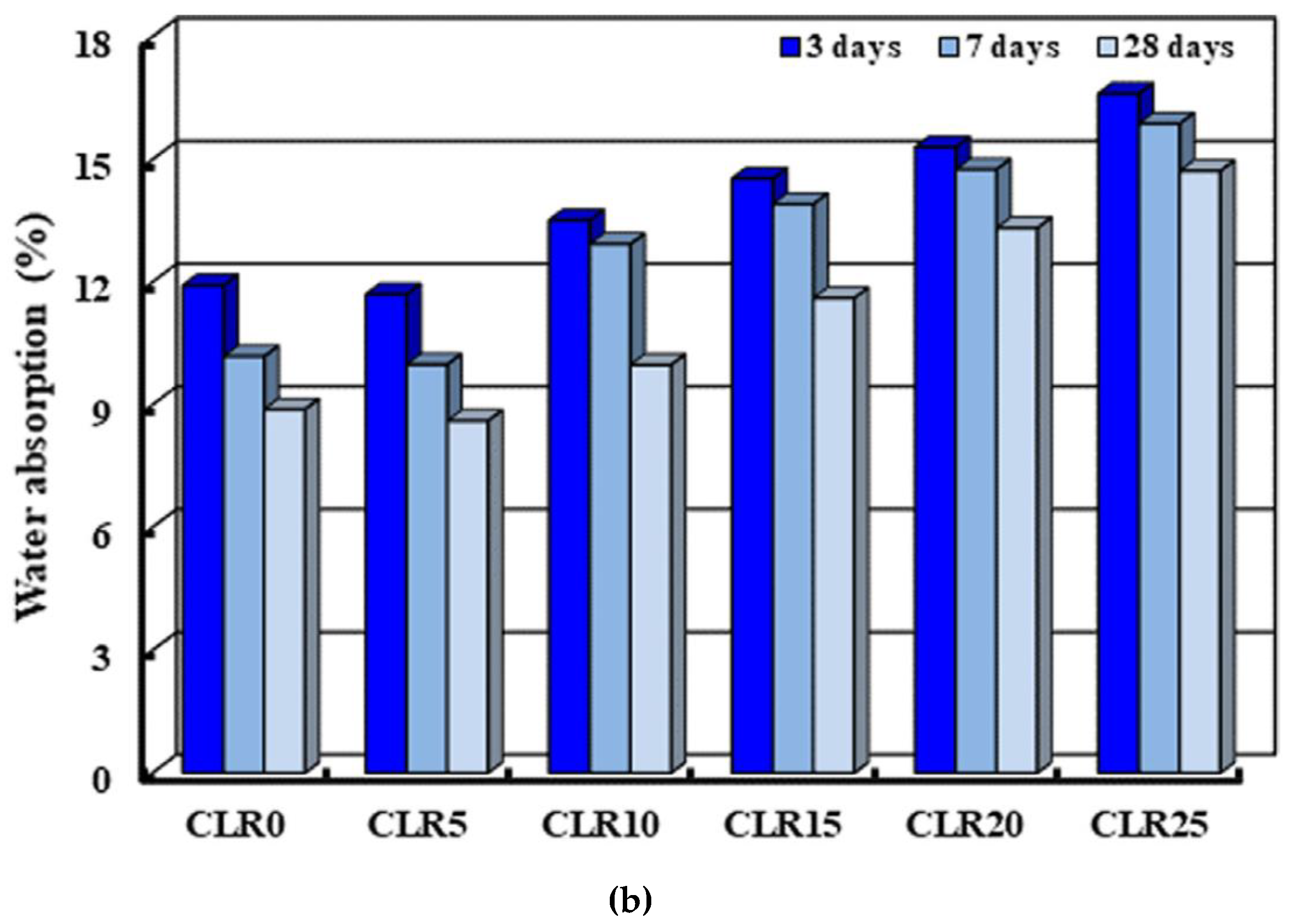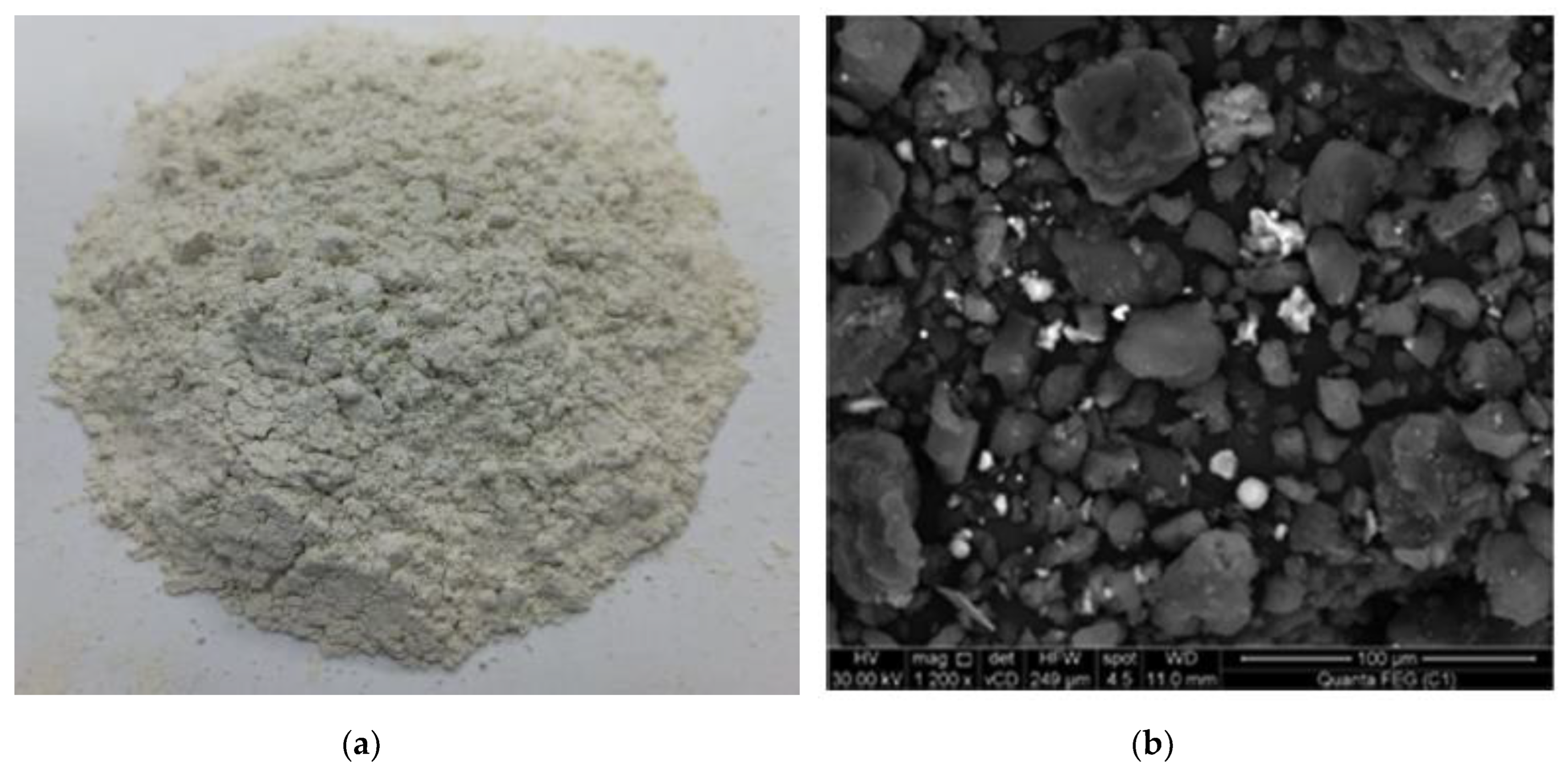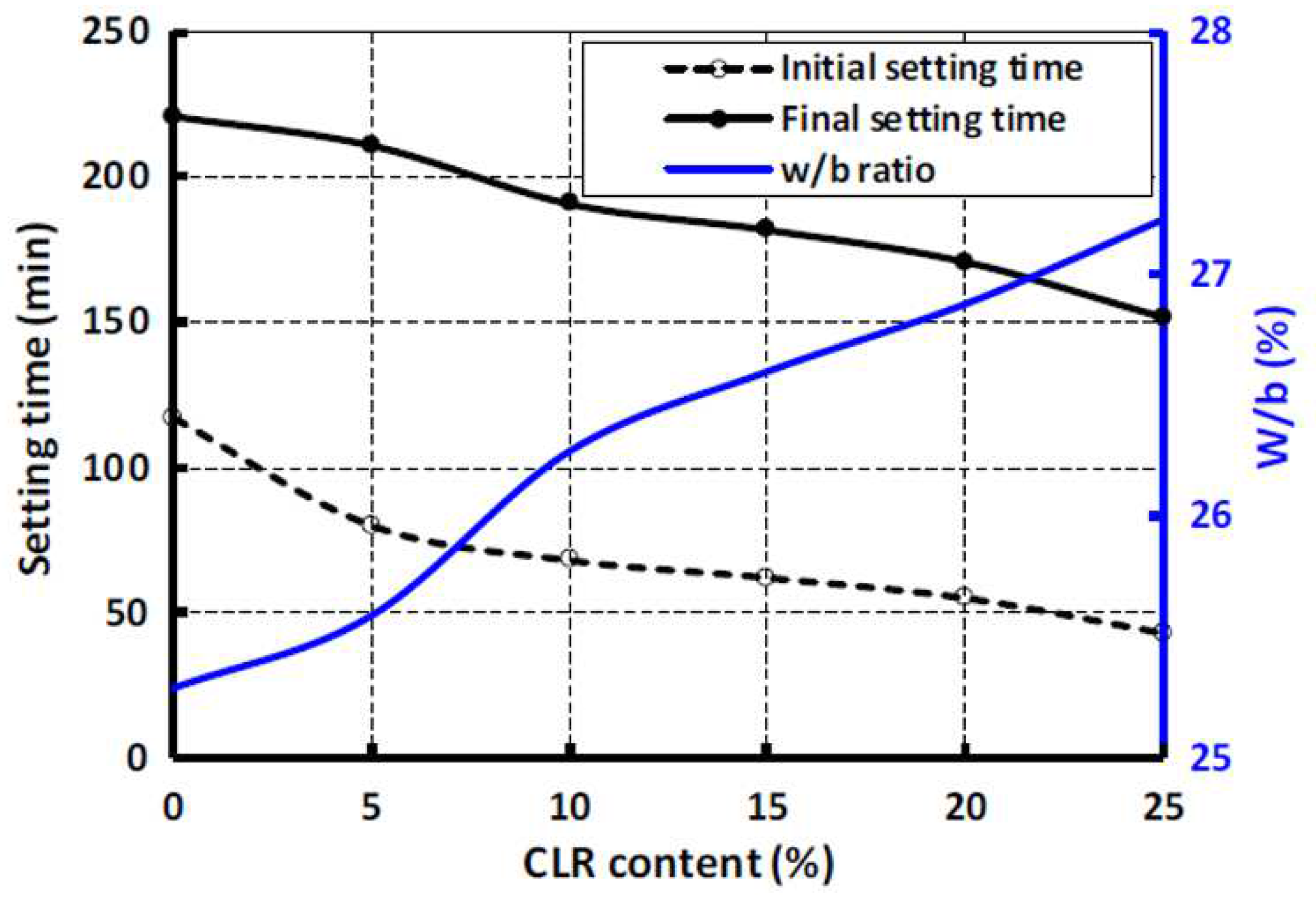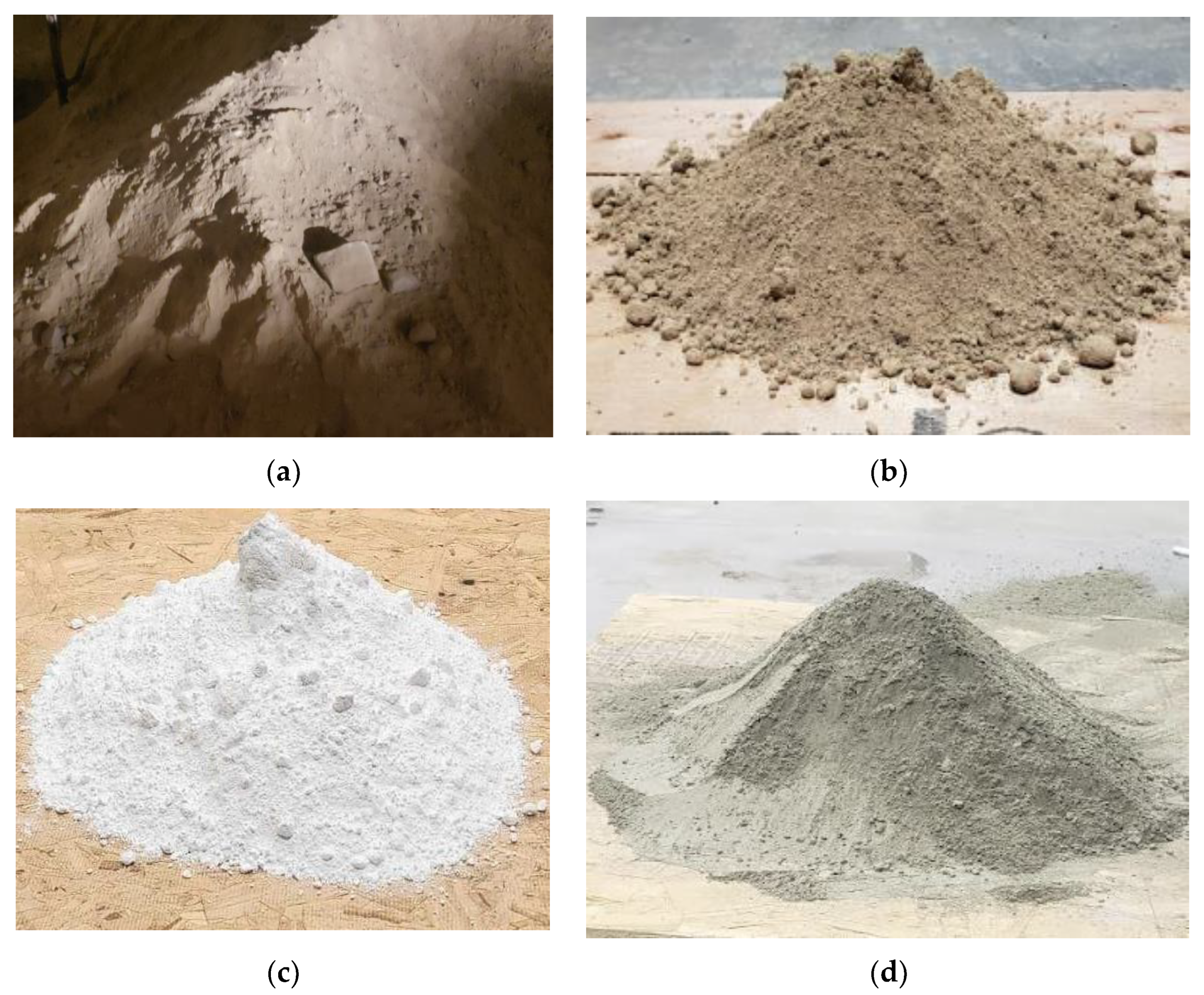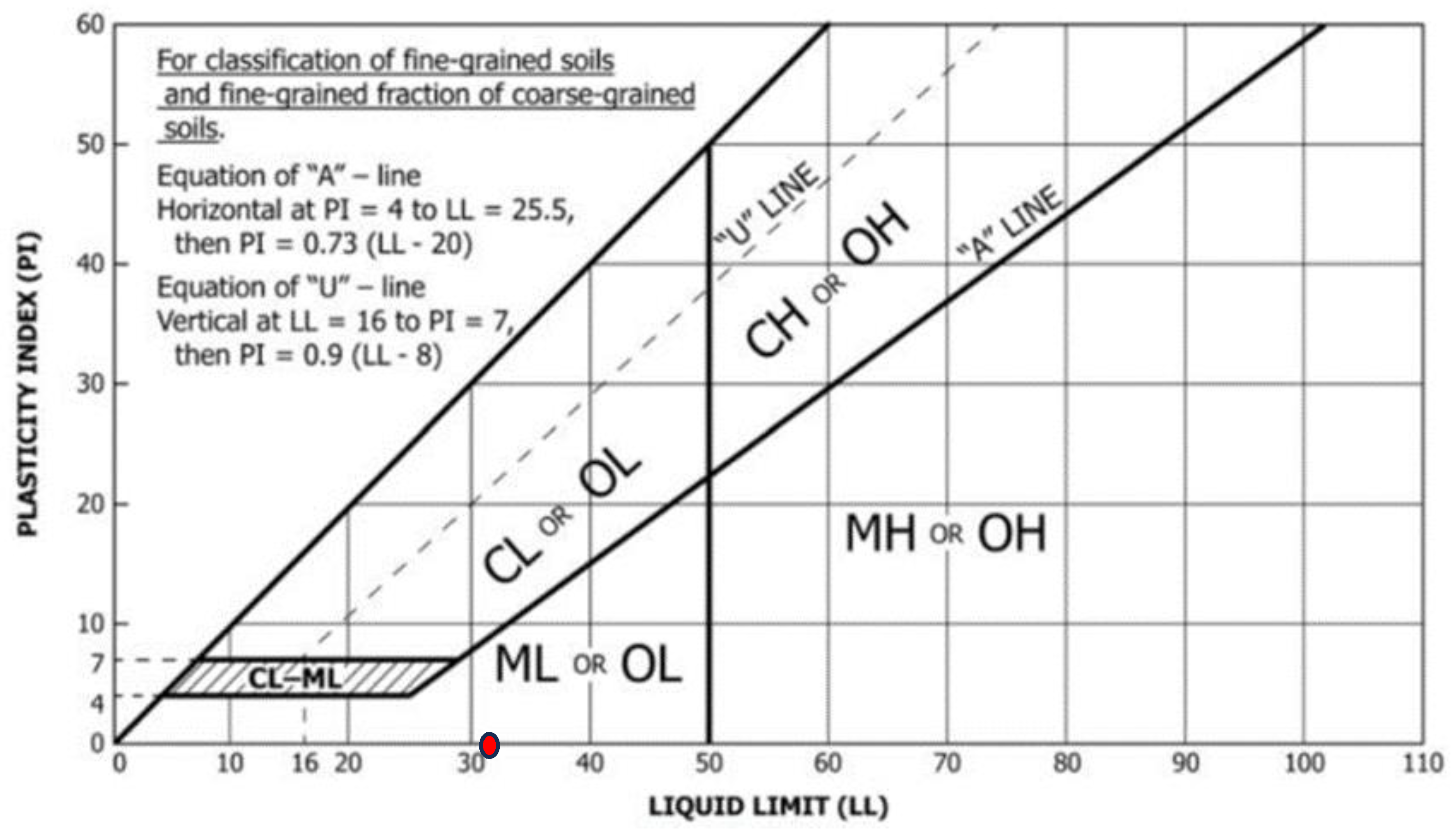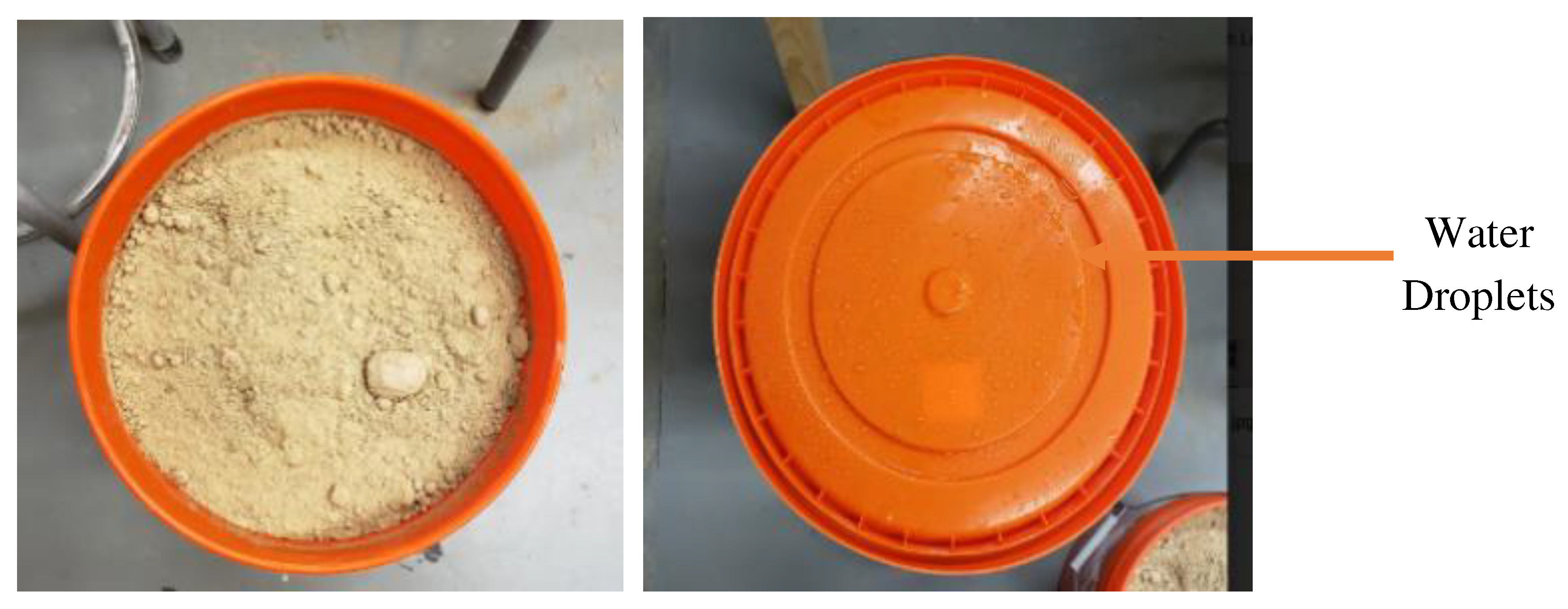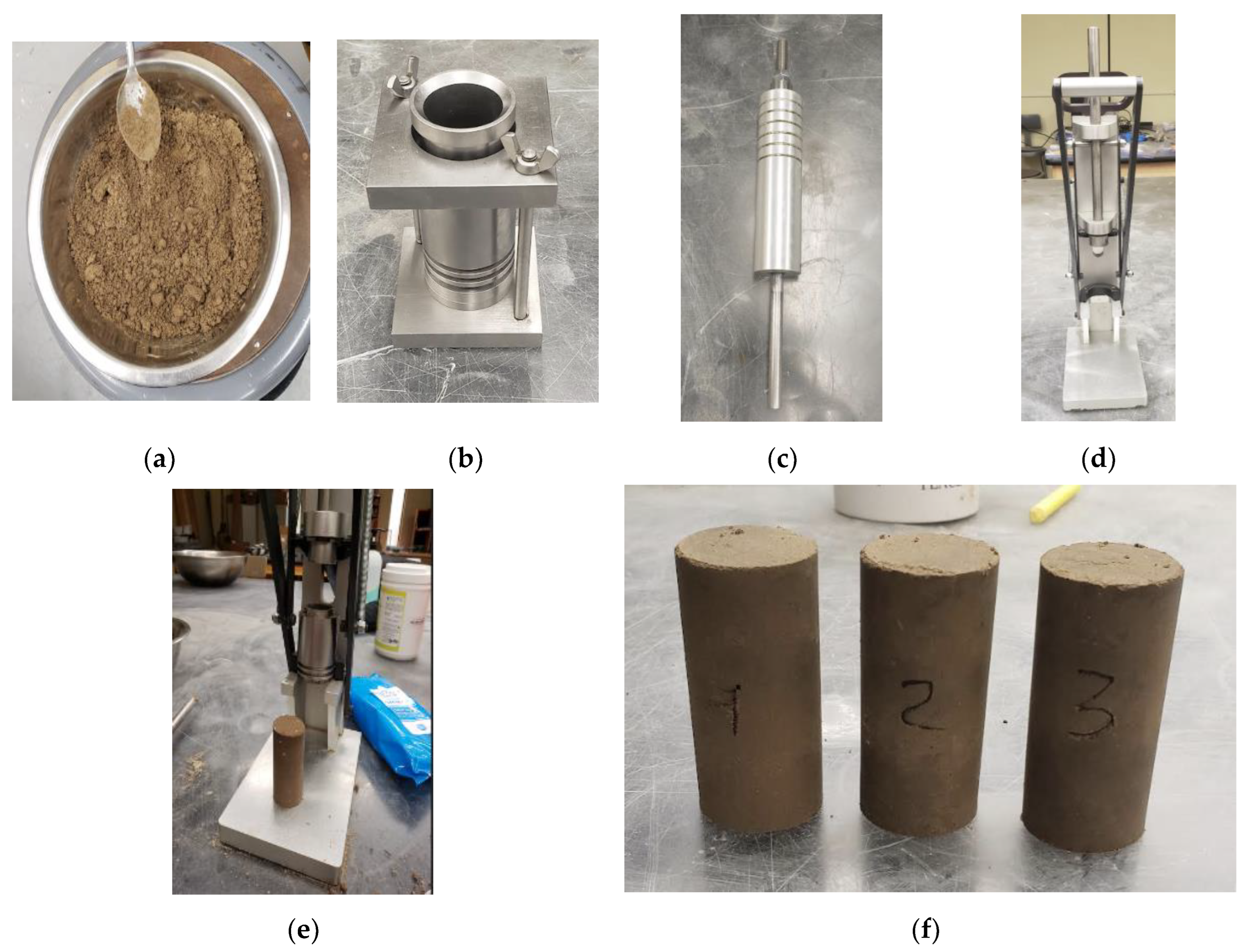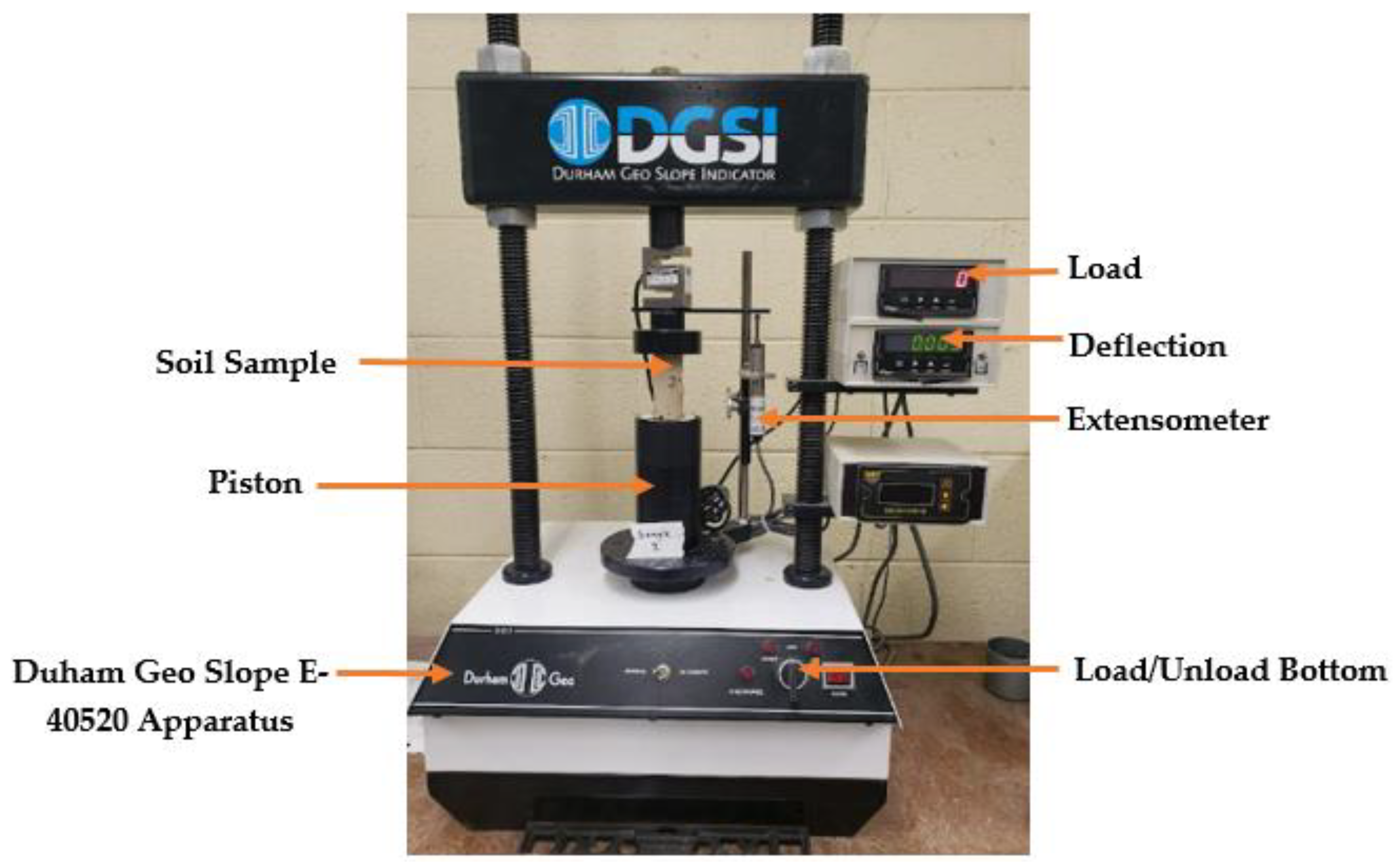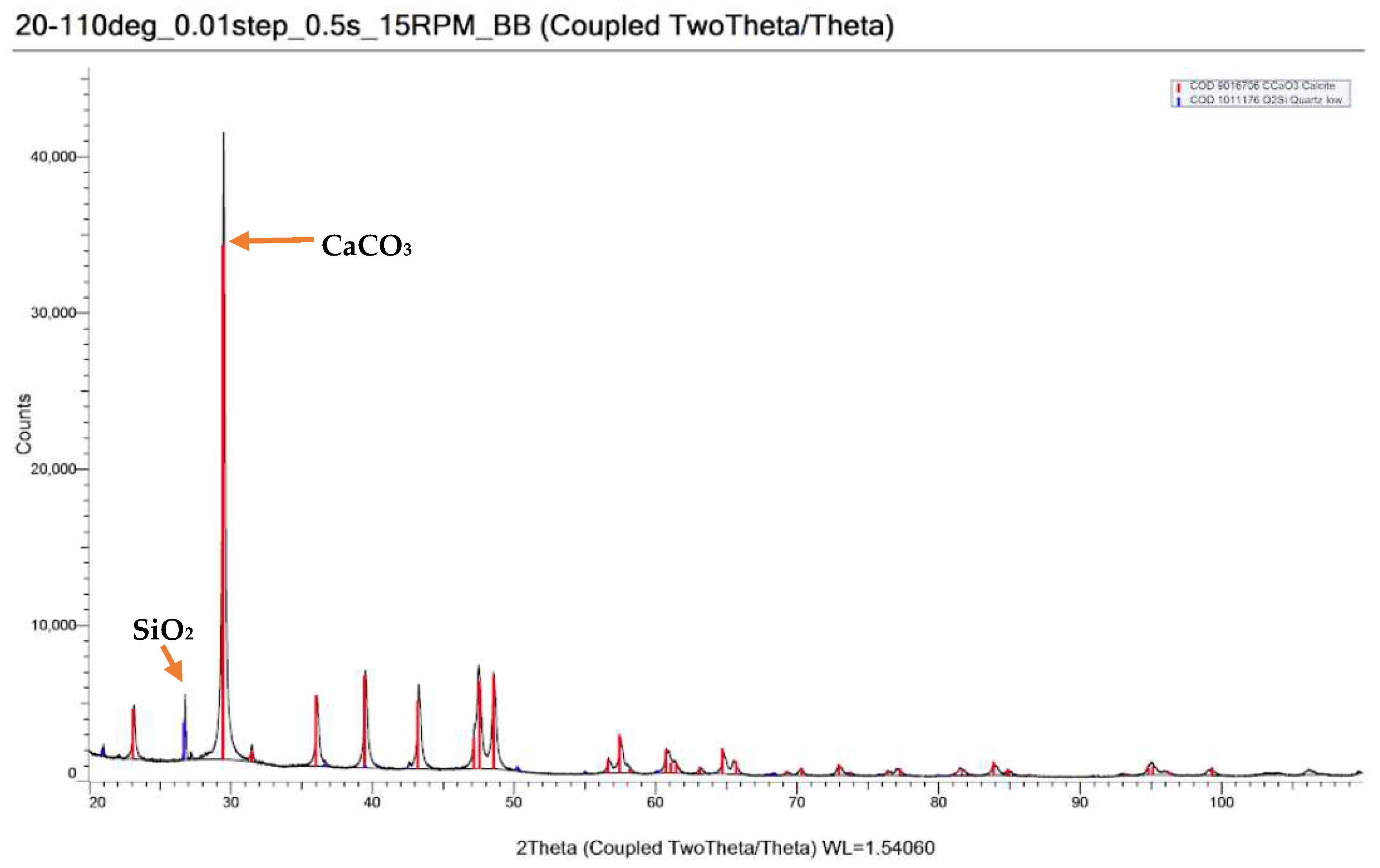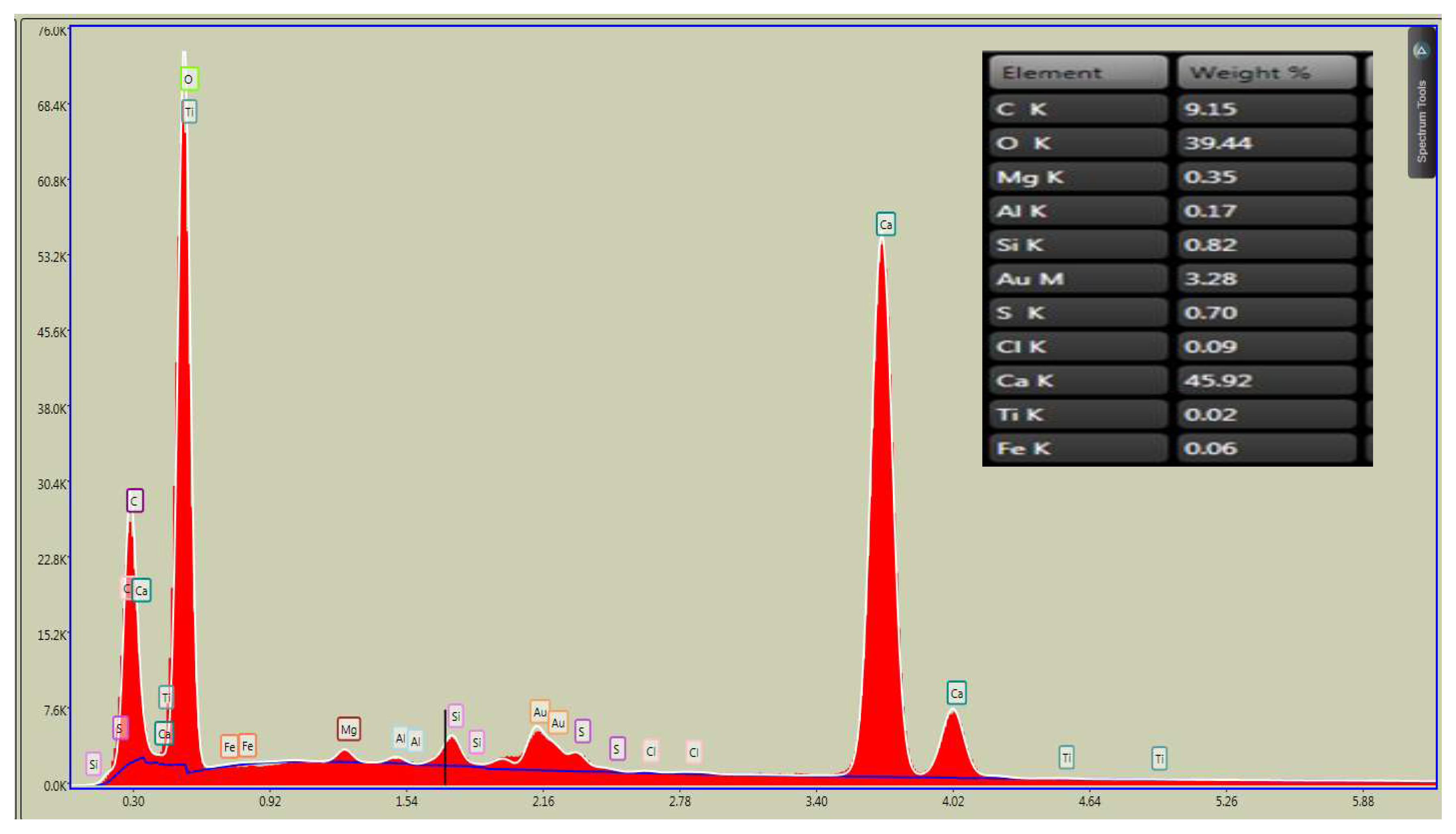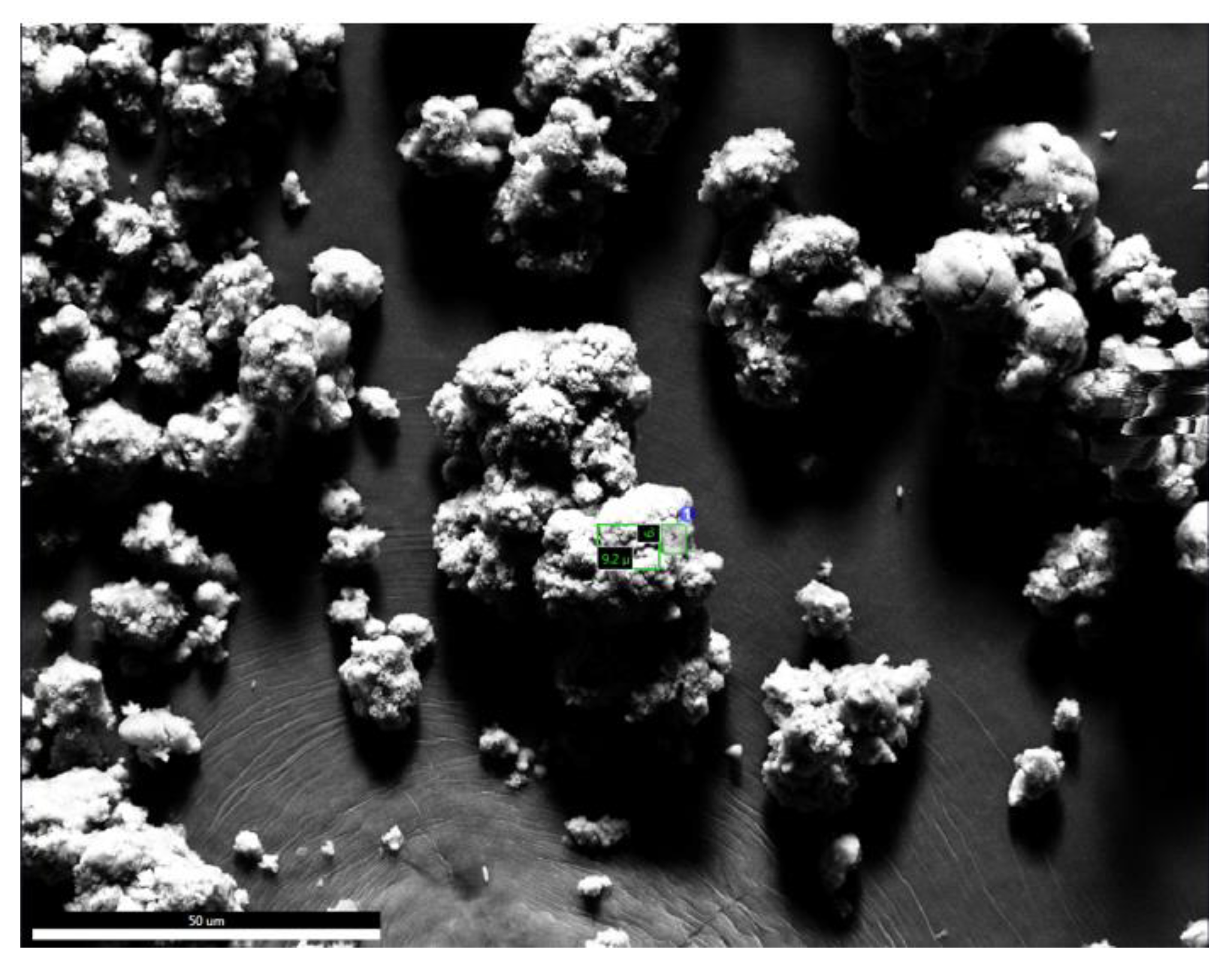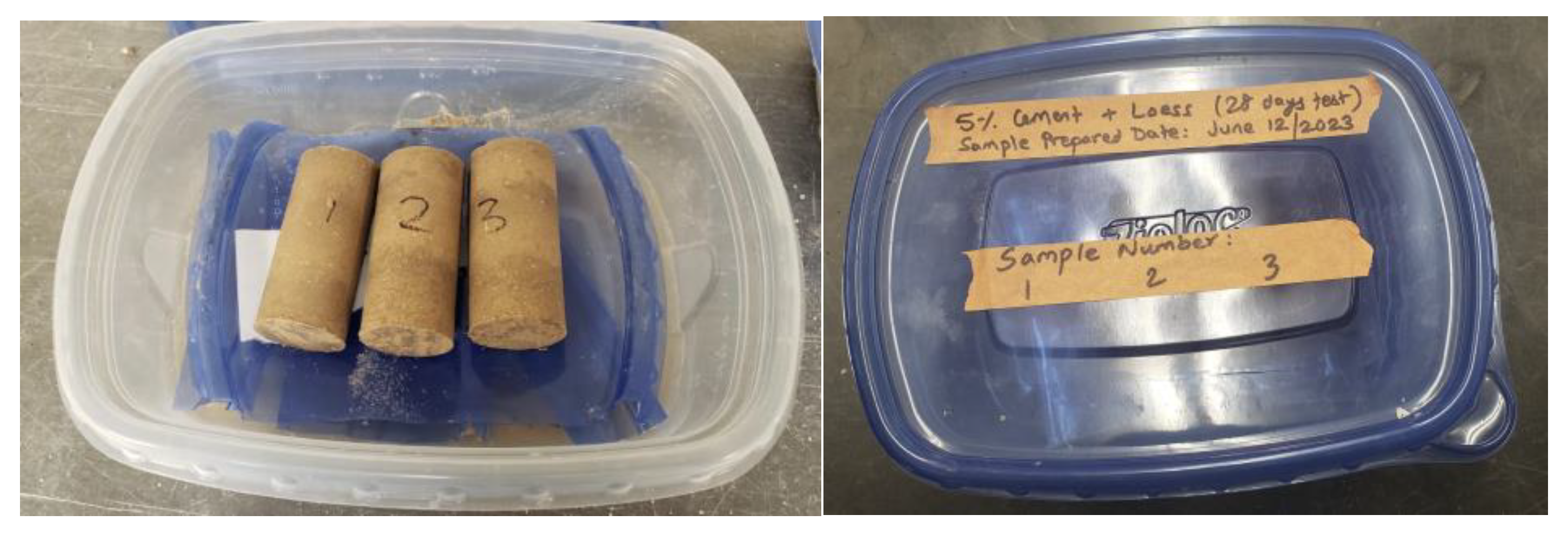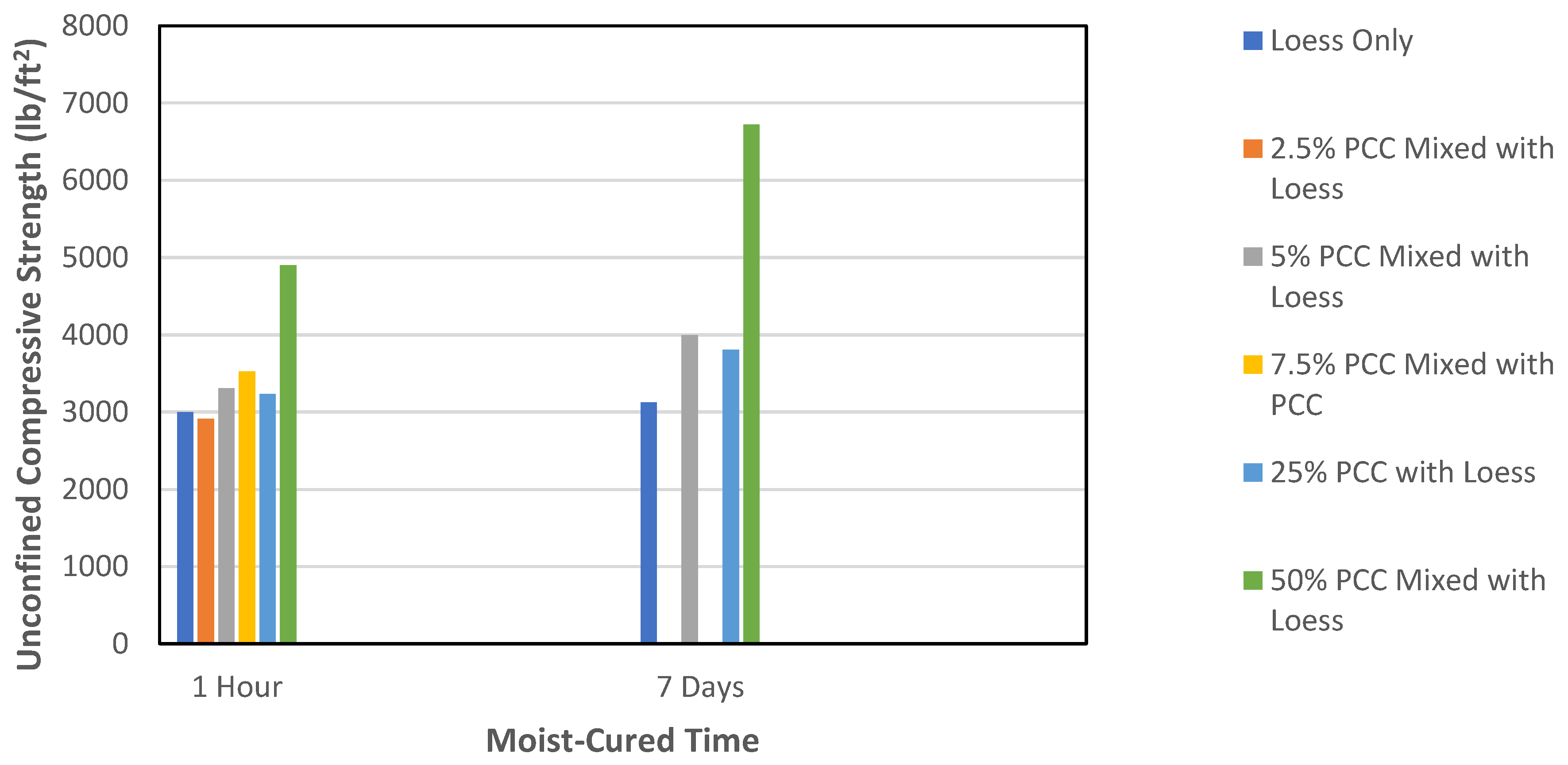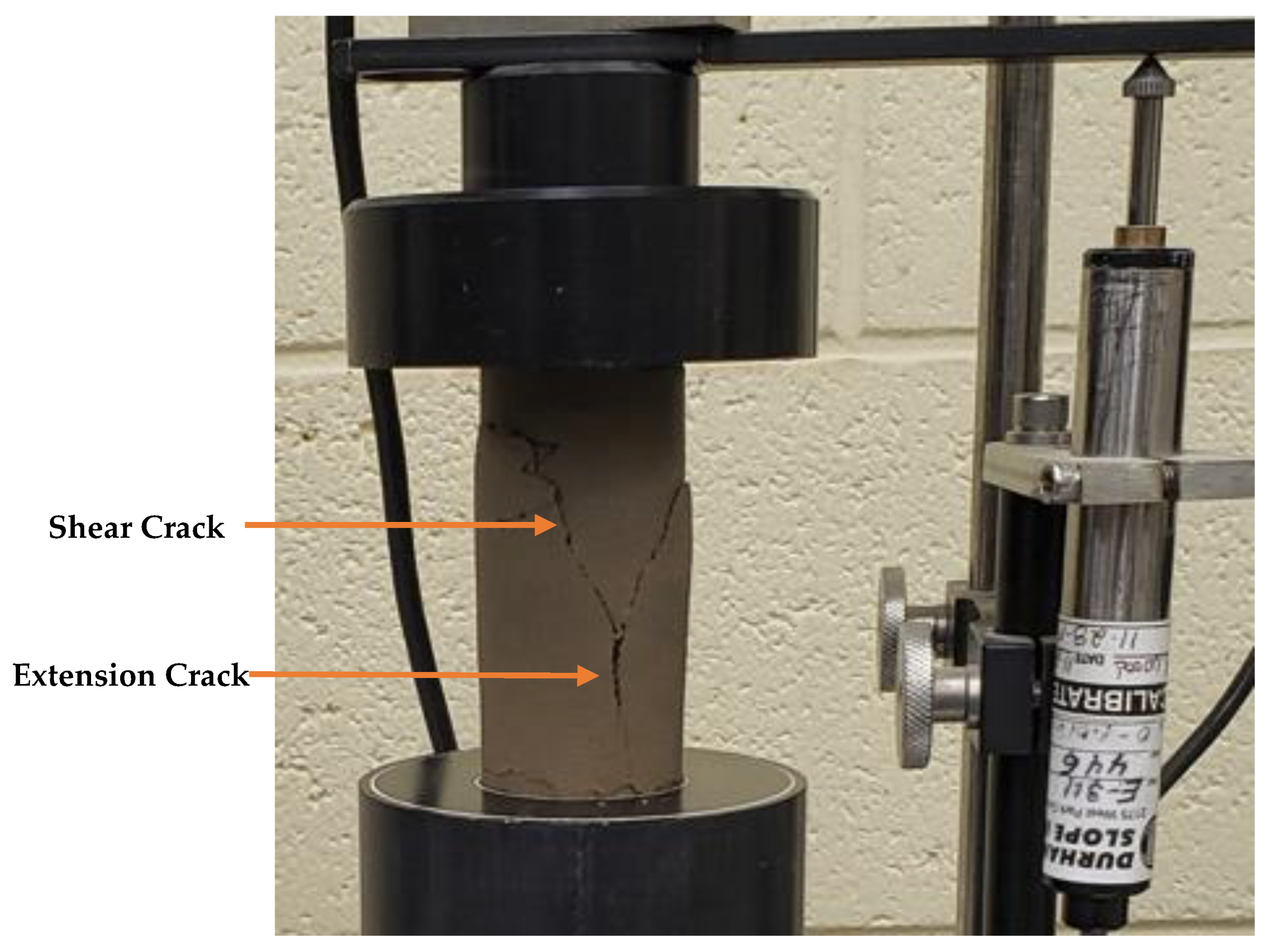1. Introduction
Two general methods are used to improve the performance of soils: soil modification and soil stabilization [
1]. The process of altering the physical properties of the soil (such as a reduction in water content) with or without additives to improve the engineering properties of fill while creating a stable working surface during construction is termed soil modification [
2]. The process of adding proper quantities of binders (cement) to increase the intact strength of the soil is called soil stabilization [
3,
4,
5]. Soil modification may include the use of lime to dry the soil to produce a workable material that can be properly compacted to the specified requirements. Moreover, lime decreases the soil plasticity, moisture absorption capability and swelling behavior, primarily in clay soils. Soil stabilization is achieved when the soil-cement or soil-lime mixture has cured long enough to allow the pozzolanic reactions to bind the soil particles. Cementation helps to improve compressibility, reduce permeability, and increase the durability, strength, and resistance to fracture, fatigue, and moisture as well as to reduce swelling and/or settlement of structures [
4,
6,
7,
8]. However, soil stabilization can be affected by the presence of organic matter, sulphates, pH of the soil, clay minerals, natural drainage, weathering conditions and the presence of carbonates and silica-alumina ratios [
9]. Cement stabilization is affected by the amount of water present in the soil impurities, additives, and specific surface area of the soil mix [
4,
10]. There are different types of Portland cement available in the market such as Type I, II, IIA, III, IV, and V which are used in stability applications [
11]. The use of the appropriate cement depends on the type of soil to be stabilized [
4]. However, Type I and III are typically used in soil stabilization. These cements help to decrease cohesiveness (plasticity), reduce the volume expansion or compressibility, and increase the strength of clayey soil [
4]. In addition, it helps to increase the elastic modulus and resistance to freeze and thaw and moisture degradation [
8]. Soil modification and stabilization are mainly done by using calcium-based materials such as cement, quicklime, and hydrated lime. Cement is mainly used for granular materials such as silt and sand whereas lime is used for silt and clay.
Another advantage of the use of soil cement is to accelerate construction schedules by strengthening weak soils, reducing soil excavation depths down to a stronger stratum, and eliminating the need for replacement of the excavated soil with stabilized materials. Certain types of cement can significantly increase the unconfined compressive strength (refer to
Section 2.2 in this report) of soil-cement mix and, in some instances, produce a five-fold increase in compressive strength.
Lime is useful for improving various soil types but provides more benefits in clay soils [
12]. Calcium cations from lime are exchanged with sodium cations in the clay and help stabilize the space between the silica tetrahedra. Moreover, the calcium ions in the lime react with aluminates and silicates in clays and form a calcium silicate or calcium silicate hydrate (CSH), which is very important in soil-lime bonding [
3,
13]. Lime modification or stabilization is affected by soil and lime type, lime amount, compaction, curing period, and use of additives like fly ash, Portland cement, sodium metasilicate, sodium sulfate, and sodium hydroxide [
14]. The lime stabilization process can be used for fine-grained soils such as clay, silty clay, clayey gravel, and sandy clay but is not suitable for granular or sandy soil [
14,
15]. In fine-grained soils, the lime can increase the soil resilient modulus by a factor of 10 or more and increase the shear strength by a factor of 20 or more when the lime is properly blended to a suitable depth [
15]. Lime also increases the plastic limit while reducing the plasticity index and thus the plastic behavior of clay soil [
14]. Proper mixing in lime stabilization has several benefits such as reduction in soil excavation or replacement, infiltration, and improved frost resistance. The author also claims a reduction in the carbon footprint [
12]. The disadvantages of lime stabilization include a reduction in the pH, nutrient level, microbial activity, and health and safety risks for workers and communities [
12]. A lime content of 4% to 6% is typically used for civil works projects [
16]. However, large amounts of lime are needed for the most adverse conditions. Lime stabilization should be performed at a temperature not less than 40 degrees Fahrenheit because lime requires sufficient heat for proper interaction with the soil [
17].
1.1. Research Gaps
There are a limited number of products used in the soil modifications and stabilization industry. Portland cement, Lime (Calcium Oxide and Hydroxide), and fly ash are used in many applications. Fly ash does not provide a level of bond strength like that in Portland cement and lime. From an environmental standpoint, the production of Portland cement and lime generates significant quantities of carbon dioxide. The production of Portland cement alone contributes approximately 7% to global carbon emissions [
18]. Further, for every pound of cement, approximately 0.9 pounds (lb) of carbon dioxide (CO2) is produced [
19]. Both cement and lime manufacturing involve heating limestone (CaCO3) at high temperatures, which releases carbon dioxide (CO2). Production of one ton of lime produces about 0.75 tons of CO2 [
20]. The amount of CO2 released also depends on the chemical composition of the fuel and the heat per ton of quicklime, ranging from 0.2 to 0.45 tons of CO2 per ton of quicklime [
21]. Because of the lack of water in quick lime, quick lime utilization can have some health and safety issues such as skin burns [
16]. Quick lime is dusty and is transported as gravel with a grain size equal to or greater than the number 4 sieve. To help mitigate the dust problem, quick lime is mixed with water and make a slurry [
22]. Because of the negative conditions of using Portland cement, lime, and fly ash, the engineering community is studying new methods and products to stabilize soil. One such product is Precipitated Calcium Carbonate (PCC) produced as a waste product of the sugar beet industry. If successful, PCC can be used in lieu of Portland cement, lime, and/or fly ash which will result in a lower carbon footprint. PCC is available; the only expense is for transportation to the site. In the carbon picture, it must be understood that the present production of sugar from beets generates about 0.68 lb. of CO2 emissions per pound of sugar beet [
23]. However, the beneficial effect of using PCC is not only cost but also sequestering of carbon which does not occur in the cement industry. PCC is available locally (within 120 miles) at no cost other than transportation to the job site.
1.2. Research Objectives, Motivations, and Scope
The main objective of this research is to use a waste product and at the same time reduce the carbon footprint in the soil cement stabilization process. Various organizations such as International Energy Agency (IEA), the United States Environmental Protection Agency (US EPA), the Idaho National Laboratory (INL), the Center for Advanced Energy Studies (CAES), and the National Academies, are planning to reach net zero carbon emissions in 2050 [
24]. Net zero emission can be achieved through a balance between the amount of greenhouse gas emitted and removing carbon dioxide from the atmosphere [
25]. Net zero carbon emission can be facilitated if PCC can be substituted for Portland cement and/or lime in soil stabilization applications. The substitution of PCC for other green-house gas generating binders depends on the engineering properties of the PCC mix and whether PCC can or cannot stabilize subgrades and foundation soils. This is the intent of this study.
In southeastern Idaho, wind-blown soils known as loess are vulnerable to saturation collapse in subgrades beneath highway pavements. The site of this research is the Pocatello, Idaho area which has large, near-surface deposits of wind-blow silt which are the subgrade soils beneath local streets and two interstate highways. The research on PCC stabilization of loess subgrades was conducted at the engineering laboratory at Idaho State University (ISU). The initial phase involved identifying the chemical elements present in PCC. Subsequently, compressive strength tests were performed on compacted soil samples mixed with different percentages of PCC to evaluate its effectiveness in stabilizing subgrades. Compressive strength tests are an indicator for evaluating the load-bearing capacity of subgrades beneath pavements. In this project, the unconfined compressive strength tests were performed for 1 hour, 7 days, and 28 days to evaluate any strength gain as a function of increasing time. If left untreated and exposed to water, compacted wind-blown silt subgrades experience strength loss, resulting in significant pavement damage, and reducing the lifespan of the pavement. Thus, the justification for the study along with the carbon foot.
1.3. Literature Review
1.3.1. Precipitated Calcium Carbonate (PCC)
Precipitated Calcium Carbonate (PCC) also known as (Carbonation Lime Residue [CLR] or Carbonation Mud and Calcined Carbonation Lime Residue [CCR] when limestone is added to CLR) is a waste product of the sugar beet industry (see
Figure 1 [a]). In 2019/2020, worldwide sugar consumption was about 171.69 million metric tons and was projected to reach 178.84 million metric tons in 2023 [
26]. The production of sugar from beets is about 32% worldwide; the remaining production is from sugar cane [
27].
The top five countries that produce sugar from sugar beets are the United States (US), Turkey, Ukraine, China, and Egypt [
28]. The average daily sugar consumption per person in the US is 126.4 grams [
29]. This explains that large quantities of PCC have been landfilled in the United States. The article
Beets and Carrots could lead to Stronger and Greener Buildings [
30] explains that nanoplatelets of PCC can improve the mechanical properties of concrete. Nanoplatelets are particles of PCC with irregular and angular shapes (see
Figure 1 [b]). This proves that PCC can be added to stabilize soil.
Information on the possible use of PCC (CLR) as a cementing agent in the soil is taken from the concrete industry. M. Rashad and Gharieb performed studies on concrete where cement was replaced by 5% (CLR 5), 10% (CLR 10), 15% (CLR 15), 20% (CLR 20), and 25% (CLR 25) Carbonation Lime Residue [
28]. The sugar beet waste used in these experiments was produced by the Saudi Sugar Company (Jeddah-Saudi Arabia). M. Rashad and Gharieb found that the higher the CLR (or PCC) percent in concrete: the lower the set time and bulk density and the higher the porosity, water demand and fines content (see
Figure 2).
M. Rashad and Gharieb also developed relationships between CLR content and unconfined compressive strength/water absorption (see
Figure 3 [a] and 3 [b]) [
28]. The highest strengths were at CLR contents of 5% by weight cement and were essentially the same as in the baseline mix. The compressive strength decreased progressively with increasing CLR content. Further, the higher the CLR substitution for cement, the greater the absorbed water in concrete. The authors report a specific gravity of 2.55 for CLR.
Figure 3.
(a) CLR Concentration and Compressive Strength.
Figure 3.
(a) CLR Concentration and Compressive Strength.
Figure 3.
(b) CLR concentration and Absorption in Concrete [
28].
Figure 3.
(b) CLR concentration and Absorption in Concrete [
28].
2. Materials and Methods
Precipitated Calcium Carbonate (PCC) used in this study was collected from Amalgamated Sugar Corporation in Twin Falls, Idaho. The PCC samples were taken from stockpiles and were in both powder and granular form with particle sizes up to 1/2 in. (see
Figure 4 [a]). XRD analysis on the PCC shows a high percentage of calcium carbonate (see
Section 3.1). Samples of wind-blown silt were collected from the basement of Colonial Hall on the Idaho State University (ISU) in Pocatello, Idaho, United States (see
Figure 4 [
22]). Colonial Hall was built in 1910 and has undergone settlement (seismically induced saturation collapse) of more than 7 in. during the past 110 years [
31]. The native loess effervescences in 10 Normal Hydrochloric acids because of the presence of calcium carbonate, which is also a cementing agent in soil. The baseline mix using Portland cement was produced by the Ash Grove Cement Company and Type S Hydrated lime was produced by Chem-star (Chemical Lime Company). Both the Portland cement and Type S Hydrated lime were purchased from the local home depot.
2.1. Soil Type
Fine-grained soils such as those used in this study are classified based on the Atterberg Limits tests that yield moisture contents in the clays and silts behave as liquids (Liquid Limit) and semi-solid materials (Plastic Limit). The soil used in this project has a liquid limit of 20.9% and a plastic limit of 21.61%. Since the water content at the plastic limit is greater than the water content at the liquid limit the loess is non-plastic. The liquid and plastic limits were determined by following the test procedures given in ASTM D4318 [
32,
33]. The soil is classified as an elastic silt (ML) in the Unified Soil Classification System
Figure 5 by red circle [
34]. In the AASHTO classification system, the loess is classified as A-4 (0).
2.2. Sieve Analysis on Project materials
The sieve analysis of the loess was performed using ASTM D422 [
36]. The percentage passing through different sieve sizes are 100% for 3/8 in., 98.43% for No. 4, 94.93% for No. 10, 90.40% for No. 40, 84.49% for No.100, and 78.37% for No. 200 [
37]. The loess sample used in this study is finer than the No. 40 sieve.
The sieve analysis of dried PCC samples shows that the percentage passing through different sieve numbers is 97.79% for 3/8 in., 93.55% for No. 4, 85.61% for No. 10, 71.44% for No. 40, 47.66% for No. 100, and 19.32% for No.200. The reason behind the small amounts of PCC passing through No. 100 and No. 200 is due to the presence of high-water content in PCC.
2.3. Sample Preparation
The effects of Precipitated Calcium Carbonate on stabilizing wind-blown silt subgrades were evaluated by performing unconfined compressive strength tests on samples containing varying amounts of PCC (see
Figure 6). Laboratory tests were carried out with different percentages of PCC (2.5% to 50% by weight) and Portland cement (5 and 25%) mixed with local collapsible soils at water contents. The natural water content (weight water divided by weight solids in per cent) in the loess was typically 2.7% (2% to 3%) while the water content in the PCC samples was about 27%; free water was present on the bucket lid.
The loess was prepared by first sieving the silt through a #40 sieve. PCC percentages of 2.5%, 5%, 7.5%, 25% and 50% of 491 grams dry weight of loess were mixed with the soil. Water was then added to the sample to meet the pre-compaction water content in the range of 14% and 16% (by weight solids). The soil mix was thoroughly blended to obtain a uniform moisture content and then compacted using the Harvard Miniature Compaction Device (see
Figure 7 [b, d]). The soils were compacted in the Harvard device using the following procedures on three samples of each mix (see
Figure 7 [f]):
Lubricate mold (see
Figure 7 [b]) with form oil to facilitate sample extraction.
Add soil mix to the mold in one-third height increments.
Each lift compacted 25 times using the standard Harvard Miniature tamper (see
Figure 7 [c]) to ensure proper compaction.
Remove mold from the clamp, spacer disc and collar then insert the sample into the ejector.
Push the sample out of mold with an ejector (see
Figure 7 [d]). Press down the piston firmly, to push soil sample out of mold (see
Figure 7 [e]).
2.4. Compressive Strength Tests
Unconfined compressive strength, also known as uniaxial compressive strength, refers to the capacity of a material to withstand axial compression forces [
38]. In this study, unconfined compressive strength tests were conducted on compacted cylindrical samples consisting of wind-blown silt, silt mixed with PCC, silt mixed with cement, and silt mixed with Type S Hydrate Lime alone following ASTM D 2166-06 [
39]. The tests were carried out using the Durham Geo Slope E-40520 apparatus, as illustrated in
Figure 8. Compression tests were conducted at approximately 1 hour, 7 days, and 28 days after mixing. The maximum load at failure was recorded, and the compressive strength was determined using Equation 1.
where: f ′
c = unconfined compressive strength (psi); P
max = maximum applied load until failure (lb); A = corrected cross-sectional area of soil cylinder for radial distortion (in
2).
3. Results
3.1. Chemical Composition of PCC
Samples of PCC were transported to the Idaho National Laboratory (INL) for comprehensive analysis utilizing X-ray Diffraction (XRD), Energy Dispersive X-ray Spectrometer (EDX), and Scanning Electron Microscopy (SEM) techniques. Dr. Kunal Mondal, an expert at INL, conducted the sample preparation, diagnostic tests, and data interpretation. The phase composition data were acquired by examining powder X-ray Diffraction (XRD) patterns obtained from a Bruker D8 Advance instrument (German) and employing Cu Kα radiation with a wavelength of 1.5060 Angstrom. The XRD analysis was performed using LYNXEYE XE-T and Bragg-Brentano geometry, covering a 2-theta range of 20° to 110° with a step size of 0.01° and a dwell time of 0.5 seconds. The substrate rotated at 15 rpm, while the goniometer was 280 mm. For SEM and EDX analyses, an FEI Quanta FEG 650 microscope was used, coupled with an EDAX Octane Plus detector for Energy-Dispersive Spectroscopy (EDS).
XRD allows for the examination of the crystallographic structure of materials; however, it does not provide quantitative data on element concentration. The XRD results indicated a high concentration of calcite (CaCO
3) followed by quartz (SiO
2) in the PCC sample (refer to
Figure 9). The red line in
Figure 9 represents the presence of calcite while the blue line represents quartz. To determine the exact amounts of calcium, oxygen, carbon, and other elements in the sample, additional analytical techniques such as spectroscopy must be employed.
The EDX analysis generated an EDX spectrum, which presents the intensity of x-rays emitted at different energy levels (as shown in
Figure 10). The x-axis represents the energy or wavelength of the x-rays, while the y-axis represents the intensity of the detected x-rays or x-ray counts at each energy level. A higher peak or count on the y-axis indicates a more intense X-ray emission at a specific energy level, signifying a higher concentration of the corresponding element in the sample. The x-axis represents the energy in kiloelectronvolts (keV) and the y-axis represents the intensity count. Additionally, the inset table in
Figure 10 lists the elements detected in the PCC sample, along with their respective weight percentages. The table provides a quantitative breakdown of the elemental composition present in the PCC. The EDX analysis revealed that calcium constituted the highest percentage (45.9%) followed by oxygen (39.4%). Other detected elements include potassium, magnesium, titanium, and iron. Notably, the analysis indicated that PCC contains up to 9% carbon by weight, which justifies its sequestration in soil-cement applications.
To obtain a detailed visual representation of the surface morphology and microstructure of PCC, a high-resolution Scanning Electron Microscopy (SEM) image was used (refer to
Figure 11). The image shows the PCC particles having irregular and sub-rounded microstructure, providing information on the physical properties of PCC at a microscopic level.
3.2. Unconfined Compressive Strength Test Results
A series of unconfined compressive strength tests were performed on the following compacted samples: native loess, loess with variable percentages of PCC, loess with different amounts of Portland Cement, and loess with various amounts of Type S Hydrated Lime. All samples were prepared at moisture contents close to 14% to 16% by total solid weight. The samples were moist-cured above a water bath prior to performing the compression tests (see
Figure 12). Moist cured is defined as samples placed in water bath above the water enclosed in a container to prevent moisture loss and to hydrate the samples. This type of curing method is different from hydration methods in which samples are placed in the water.
Unconfined compressive strength tests were performed for approximately 1 hour and at 7 and 28 days after the test cylinders were prepared. The main objective was to determine whether PCC provides any beneficial increase in strength. If yes, the aim was to find the optimum PCC content in stabilizing loss and sequestering carbon from PCC and reducing the use of Portland cement and Type S Hydrated Lime. Companion tests were performed on soil mixed with Portland-cemented or Type S Lime for comparison purposes with the PCC test results. The typical dimensions of compacted soil or soil-cement cylinders prepared in the laboratory are measured with a micrometer and are given in
Table 1.
3.2.1. Unconfined Compressive Strength Test Results for Loess Mixed with PCC
3.2.1.1. Introduction
Unconfined strength tests were performed on compacted samples of loess to determine the effect of adding PCC on compressive strength. The samples were moist-cured to normalize the testing procedures used in the mix designs.
3.2.1.2. One-hour Strength Test Results
The overall average compressive strength of the compacted loess itself in the one-hour moist-cured test was 3003 lb/ft
2. There was no evidence of crack formation in the samples after preparation and prior to performing the tests. In the next series of tests, various proportions of PCC at 2.5%, 5%, 7.5%, 25% and 50% by dry-weight loess were added to the loess. The resulting mixes were compacted and moist-cured for 7 and 28 days. The testing sequence in each set began with sample 3 (the final prepared sample) and concluded with sample 1 (the initial prepared sample).
Table 2 displays the unconfined compressive strength test results of compacted loess and with and without PCC for a one-hour moist cured time.
Table 2 shows that the addition of 2.5% PCC (by dry weight loess) does not increase the one-hour strength. The average compressive strength of 2.5% PCC blended loess was 2912.6 lb/ft
2 whereas the average strength of compacted loess itself was 3003 lb/ft
2 in the one-hour test. The lower strength may be related to a higher water content (+2% to +4%) in the PCC-loess sample. When the PCC percentages were increased from 2.5% to 5%, the early unconfined compressive strength test results showed a slight increase (approximately 300 lb/ft
2) in the one-hour strength. However, when the PCC percentage was increased from 5% to 25%, the early unconfined compressive strength did not have the one-hour strength. The study was continued by adding 50% PCC to the same field sample. There was a significant increase in compressive strength at 50% PCC, however, the practical application of adding 50% PCC to a fill to increase the short-term (one-hour) strength is questionable.
3.2.1.3. Seven-day Strength Results
The next phase of the study was conducted for 7-day strength using the same procedures as in the first set of tests. Results are displayed in
Table 3.
The test results show an increase in the 7-day compressive strength of loess containing 5% PCC (by weight). At 25% PCC the strength was higher than the loess itself but was essentially the same as with 5% PCC. Similar to the one-hour tests, there is a significant increase in strength at 50% PCC. It is interesting to note the corresponding decrease in dry unit weight, which is typically inconsistent with unit weight/strength correlations. This appears to mean that the void ratio is higher, but the silt particles are cemented by the PCC and thus is responsible for the increased strength.
Figure 13 comparing the 1 hour and 7-day tests. The test results clearly show the expected strength gain with increasing time.
3.2.1.4. Twenty-Eight Day PCC Strength Results
To further evaluate the effect of PCC on loess, the samples were moist cured for 28 days following the strategy used in concrete because concrete gains more than 95% of its strength when hydrating for 28 days. Since adding 50% PCC to loess has practical limitations, there was no further test performed on the 50% PCC-loess mix.
Table 4 presents the unconfined compressive strength, unit weight and water content of PCC-loess samples at 28 days. The tests were performed late in the investigation on samples that may be significantly different from the ones used in the 1-hour and 7-day tests.
Based on the test results, the 28-day compressive strength increases with PCC similar to the results with lesser curing times. The difference in strength between the 7- and 28-day tests appears to be related to the lower water content in the 28-day samples. The lower water content may have a significant impact on the pozzolanic effect of the PCC. Further study on this subject is recommended.
3.2.2. Type S Lime Stabilized Soils
Lime modification and stabilizations are in practical use for many geotechnical applications. Companion strength tests on loess with and without Type S Hydrated Lime were also performed and are presented in
Table 5 and
Table 6. Similar to the PCC/loess tests, cylindrical samples were prepared using the Harvard Miniature Compactor and the samples were moist cured.
The 1 hour, 7-day and 28-day strength test results in which 5% Type S hydrated lime by dry weight was added to the Colonial Hall loess are given in
Table 5. For comparison, the strength of the compacted native loess was in the range of 2707 and 3125 lb/ft
2. The tests indicate a one-hour strength increase of roughly 300 lb/ft
2 which can be sufficient to increase the bearing of subgrades during construction. Tests at 7-days and 28-days show a significant 5-fold and 8-fold increase, respectively during the curing periods.
In the next tests, the Type S Hydrated Lime content was increased from 5 to 25% by dry weight loess. Test results are provided in
Table 6. The one-hour (short-term strength) increased significantly (1.7 times) with a 20% increase in lime. This result is important in accelerating the placement of fill during construction. However, at 7- and 28-days the strength of the lime-cemented loess was significantly lower than at the 5% concentration but also much higher than the loess itself.
Tests conducted at Idaho State University clearly demonstrate the beneficial use of 5% Type S lime by dry weight soil in long-term soil stabilization of loess. Additional tests need to be performed to assess the use of this lime in subgrade stabilization during construction. Percentages above 5% may benefit placement and stability of loess in fill but may not meet environmental restrictions.
To compare the unconfined compressive strength results from PCC and Type S Hydrated Lime, additional tests were performed adding Portland Cement to stabilize loess.
3.2.3. Portland Cement Stabilized Loess
Companion tests were performed on soil-Portland Cement mixes in which 5% and then 25% cement (by dry weight loess) were added to the Colonial Hall Loess. Local Type I/II Portland Cement was used in the experiments. Cylindrical samples were prepared in the Harvard Miniature Compactor and samples were moist-cured for 1 hour, 7-day and 28-day periods. Uniaxial compression test results are provided in
Table 7 and
Table 8.
At 5% by weight, the average one-hour unconfined compressive strength of loess-Portland cement samples (5746 lb/ft
2) is much higher than the loess itself and the lime-cemented loess. The average unconfined compressive strength underwent a significant (6-fold) increase at 7 days and a further increase (11-fold) at 28 days. However, the strengths of the Portland cement-loess were much less than the lime-loess at 7 and 28 days (see
Table 5 and
Table 7). Additional companion tests were performed on loess samples combined with 25% of Type I/II Portland cement. The results of these tests are presented in
Table 8. The one-hour strength values are essentially the same, however, the long-term strength of the samples with the 25% cement concentration was much higher than those with only 5% Portland Cement.
3.2.4. Modes of Failure
Two modes of failure were observed in all the samples at the end of the unconfined compression strength tests. Vertical cracks (extension failure) and diagonal cracks (shear failure) along with combinations of both failure modes were observed in the samples (see
Figure 14).
4. Discussion
After construction, subgrades built on compacted loess (wind-blown silt) became soft and provided inadequate bearing beneath pavements. The intent of this project is to investigate various alternatives for subgrade stabilization by adding chemicals to the soil prior to compaction. In the case of Precipitated Calcium Carbonate (PCC), there is an additional benefit of sequestering carbon formed during the manufacture of sugar from sugar beets.
The test results show an increase in the compressive strength of loess subgrades with the addition of PCC prior to compaction. The optimum per cent PCC is 5% by weight dry loess. Within 1 hour, the compressive strength which controls bearing capacity increased roughly 10 % when PCC was blended with the silt. At 7-days, the soil strength increased 30% above the untreated loess with the addition of 5% PCC. The highest strengths compared with baseline values were achieved at 50% PCC after a 28-day moist cured time, however using 50% PCC exceeds the practical limit in subgrade construction. Even though the strength values are low for cemented soils (3000 to 4000 lb/ft2), the soil cement benefits the project by increasing the resistance to softening and loss of subgrade strength facilitating construction by lowering the water content.
Subgrade stability in areas with wind-blown deposits can and has been achieved by adding lime and Portland Cement to fill materials or cut surfaces. In practice, stabilization is typically accomplished using lime in concentrations up to 5% by weight. The unconfined compressive strength values obtained in this study show that the lime (Type S Hydrated Lime) has little to no effect on increasing the short-term strength of compacted loess. However, there was a significant increase in strength at 7 and 28 days. At 25% lime by weight, the short-term strength almost doubled which is important in stabilizing wet subgrades but again is not really utilized in practice. Further, the 28-day strength of mixes with 25% lime was lower than samples prepared with 5%. This condition is typical of high-early strength soil cement, in which strength gain is rapid at the start of hydration but increases at a slower rate than in soils with lower lime contents.
Stabilization for fine-grained soils can also be achieved by adding Portland cement prior to compaction. In practice, concentrations of 5% (by dry-weight soil) are generally used to stabilize subgrades. In this research, the unconfined compressive strength of loess- Type I/II Portland cement increased both the short-term (1 hour) and long-term strength (28 days or more) of compacted loess. Moreover, the short-term strength increased by 90% and the long-term strength increased by more than 20 times the strength of compacted loess itself. With 25% by weight Portland cement, the short-term compressive strength increased by 70% (which is incrementally lower than the 5% Portland cement mix), however, the long-term strength was 37 times than the strength of loess by itself. Again, in soil stabilization practice, the percentage of Portland Cement added to stabilize soil is typically 5% or less by weight. In some applications, where Portland cement is needed to reduce the water content of the soil, the percentage has been from 5% to 15% depending on the project types, durations, and situations.
Comparison of compressive strength values for untreated loess, PCC-cemented loess, lime-cemented loess, and Portland cemented-loess at 5% concentration are given in
Table 9. The test results show an increase in the compressive strength of the loess (300 to 1000 lb/ft
2) with the addition of 5% PCC. Much higher strengths were achieved with lime and Portland Cement but lacked the beneficial environmental effect of sequestering carbon in the manufacture of sugar.
5. Conclusions
The presence of wind-blown silt (loess) in the near-surface soils in Southeast Idaho is vulnerable to saturation collapse and settlement in compacted subgrades because of its high void ratio. This becomes a significant concern in the design of highways, parking lots and buildings, as it can lead to pavement damage and reduced pavement life.
In this study, the main objective is to utilize Precipitated Calcium Carbonate (PCC), a waste product obtained in the production of sugar from beets, for improving the performance of loess subgrades beneath the pavements. Laboratory tests conducted at the Idaho National Lab (INL) provided valuable insight into the chemical and physical properties of PCC. The X-ray Diffraction (XRD) analyses show the presence of substantial amounts of calcium carbonate in PCC. Additionally, the Energy Dispersive X-ray Spectrometer (EDX) analysis provided further details on the elemental composition by weight showing that PCC contains 45.9% calcium, 39.4% oxygen, and 9% carbon by weight. The Scanning Electron Microscopy (SEM) photos revealed the irregular and sub-rounded microstructure of PCC particles.
Based on the tests conducted at Idaho State University (ISU), the addition of 5% PCC by dry-weight loess can enhance the performance of loess subgrades by creating a 10% (short-term) to 28% (long-term) increase in the unconfined compressive strength. This study not only provides information on the utilization of a waste product generated from local sugar production but also shows its potential for sequestering carbon emissions associated with sugar production from beets. Various proportions of PCC (ranging from 2.5% to 50%) were blended with loess to determine the optimum concentration. Based on the strength test results, the optimum content is 5% PCC (by dry-weight soil). For example, when 5% PCC by dry weight of loess is mixed with loess, the resulting strength is 200 to 1000 lb/ft2 higher than uncompacted untreated loess. Clearly, the addition of PCC can be used to stabilize collapsible wind-blown silt subgrades in southeast Idaho and at the same time sequester carbon for the benefit of the planet.
Companion tests were carried out to compare the use of PCC in loess stabilization with lime and Portland cement stabilized subgrades. The tests clearly show much higher strengths with the addition of lime and Portland cement which are actually used in soil stabilization. However, the increased strength comes at an environmental cost: increased global temperatures and an enhancement of the carbon footprint.
The main expense with the use of PCC is the transportation costs. Sources of PCC are within 114 miles of Pocatello. However, if the PCC has limitations on stabilization (such as in wet soils) Portland cement and Type S Lime can be added to the PCC to further strengthen the subgrade. Preliminary tests show that the addition of 2.5% PCC, lime, Portland cement and fly ash yields a soil-mix strength of roughly 10 times that of the PCC alone.
Overall, the results show that incorporating PCC in pavement subgrades or building foundations can provide several benefits, including improving unconfined compressive strength and thus the bearing strength. Further research and tests are being considered in which other additives (such as fly ash or Type S Lime) alone or in combination with PCC are added to the native loess to improve the strength. In addition, tests on the use of PCC to stabilize other soil types such as clay are being evaluated. These studies can provide further information on the potential use of PCC in highway and building applications.
Author Contributions
Conceptualization, M.M. (Mustafa Mashal), J.W.M. (James W. Mahar) and K.P. (Kabiraj Phuyal); methodology, M.M. (Mustafa Mashal), J.W.M. (James W. Mahar); K.M. (Kunal Mondal); and K.P. (Kabiraj Phuyal); software, K.P. (Kabiraj Phuyal); validation, M.M. (Mustafa Mashal), J.W.M. (James W. Mahar); K.M. (Kunal Mondal); and K.P. (Kabiraj Phuyal); formal analysis, M.M. (Mustafa Mashal), J.W.M. (James W. Mahar); K.M. (Kunal Mondal); U.S. (Ujwal Sharma); and K.P. (Kabiraj Phuyal); investigation, M.M. (Mustafa Mashal), J.W.M. (James W. Mahar); K.M. (Kunal Mondal); U.S. (Ujwal Sharma); and K.P. (Kabiraj Phuyal); resources, M.M. (Mustafa Mashal), J.W.M. (James W. Mahar) and K.P. (Kabiraj Phuyal); data curation, M.M. (Mustafa Mashal), J.W.M. (James W. Mahar) and K.P. (Kabiraj Phuyal); writing—original draft preparation, K.P. (Kabiraj Phuyal); writing— M.M. (Mustafa Mashal), J.W.M. (James W. Mahar); K.M. (Kunal Mondal); and K.P. (Kabiraj Phuyal); visualization, M.M. (Mustafa Mashal) and J.W.M. (James W. Mahar); supervision, M.M. (Mustafa Mashal) and J.W.M. (James W. Mahar); project administration, M.M. (Mustafa Mashal); funding acquisition, M.M. (Mustafa Mashal). All authors have read and agreed to the published version of the manuscript.
Funding
The literature review for this research was supported by the Center for Advanced Energy Studies (CAES) business development funds as part of Idaho National Laboratory (INL) under the Department of Energy (DOE) Idaho Operations Office (an agency of the U.S. Government) Contract DE-AC07-05ID145142. This experimental work was supported by the State of Idaho appropriated funding for the Center for Advanced Energy Studies (CAES).
Institutional Review Board Statement
Not Applicable
Informed Consent Statement
Not Applicable
Data Availability Statement
The corresponding authors can provide the data upon request.
Acknowledgements
The researchers are thankful for the support provided by Jared Cantrell, Laboratory Manager in the Department of Civil and Environmental Engineering at Idaho State University. The authors would also like to express their gratitude to Kathryn Hogarth, Ujwal Sharma, Manish Acharya, Saksham Raj Maharjan, Ashish Deo, and the entire structural team at Idaho State University for their invaluable support. Special thanks to Dr. Carol Mahar and Kathryn Hogarth for meticulously proofreading the journal article. Recognition is also due to the Amalgamated Sugar Corporation in Twin Falls, Idaho for providing Precipitated Calcium Carbonates (PCC). The authors extend their appreciation to Dr. Bruce Savage for facilitating the acquisition of PCC from Amalgamated Sugar Cooperation. Special thanks to CAES and INL for their invaluable support for literature review and project development.
Conflicts of Interest
The authors declare no conflict of interest.
References
- Lime in Soil Stabilization] | [Graymont]. (n.d.). https://www.graymont.com/en/markets/construction-materials/lime-soil-stabilization.
- Mintek Resources. (2023, April 17). Soil modification - Mintek Resources. https://mintekresources.com/solutions/soil-modification/#:~:text=Soil%20Modification%20is%20a%20technique,%2C%20and%20shrink%2Dswell%20potential.
- Lime in Soil Stabilization] | [Graymont]. (n.d.). https://www.graymont.com/en/markets/construction-materials/lime-soil-stabilization.
- Afrin, H. (2017). A review on different types of soil stabilization techniques. International Journal of Transportation Engineering and Technology, 3(2), 19. [CrossRef]
- Team, M. (2023). The importance of soil stabilization. Mintek Resources. https://mintekresources.com/the-importance-of-soil-stabilization/.
- FM5-410, (2012). Soil Stabilization for Road and Airfield. www.itc.nl/~rossiter/Docs/FM5-410.
- Lambe, T. W. (1958). The structure of compacted clay. Journal of Soil Mechanics and Foundation. 84, 55-70.
- Fundamentals of soil stabilization Ali Akbar Firoozi1*, C. Guney Olgun2, Ali Asghar Firoozi1 and Mojtaba Shojaei Baghini1.
- Al-Kiki IM, Al-Atalla MA, Al-Zubaydi AH (2011) Long term strength and durability of clayey soil stabilized with lime. Eng Tech J 29(4):725–735.
- EuroSoilStab. (2002). Development of Design and Construction Methods to Stabilize Soft Organic Soils: Design Guide for soft soil stabilization. CT97-0351, European Commission, Industrial and Materials Technologies Programme (Rite-EuRam III) Bryssel.
- Cement types. (n.d.). https://www.cement.org/cement-concrete/concrete-materials/cement-types.
- Geology, E. (n.d.). What are the environmental and social impacts of using lime or cement stabilization for soil improvement? www.linkedin.com. https://www.linkedin.com/advice/0/what-environmental-social-impacts-using-lime.
- Parsons R, Milburn J (2003) Engineering behavior of stabilized soils. Transp Res Rec J Transp Res Board 1837:20–29.
- Mahlein, Tiedemann, & Kuska (2020). How Table Sugar is Produced from Sugar Beets. Retrieved from How Table Sugar Is Produced From Sugar Beets · Frontiers for Young Minds (frontiersin.org).
- Soil stabilzation. (n.d.). https://www.lime.org/lime-basics/uses-of-lime/construction/soil-stabilzation/.
- Guidelines for Lime Stabilization (2011). Retrieved from Microsoft Word - Guidelines for Lime Stabilization (ga.gov).
- Eric, M. Mays (2007). Building Development Policies and Procedures Administrative/General. Retrieved from Policy 1.13 Soils – Use of Lime during Construction (pwcva.gov).
- Malsang Isabel (2021). Concrete: the world’s 3rd largest CO2 emitter. Retrieved from Concrete: the world’s 3rd largest CO2 emitter (phys.org).
- Carbon Footprint. The Portland Cement Association. Retrieved from Carbon Foot Print.indd (cement.org).
- Jozef, M. Pacyna et al. (2016). Lime Production. Lime Production Guidebook 2016. European Environment Agency.
- European Commission, 2001. Integrated Pollution Prevention and Control (IPPC), Reference Document on Best Available Techniques (BREF) in the Cement and Lime Manufacturing Industries, December 2001.
- Rogers, C. D. F. and Glendinning, S. (1993). Modification of clay soils using lime. In C. a. Rogers (Ed.), Proceeding of the Seminar held at Loughborough University on Lime Stabilization (pp. 99-114). London: Thomas Telford.
- Climate Footprint (N.D.). Beet Sugar. Retrieved from Beet sugar · 0.67 kg CO2e/kg | Verified by CarbonCloud.
- Bouckaert, S. (n.d.). Net Zero by 2050: A roadmap for the global energy sector. https://trid.trb.org/view/1856381.
- What is Net Zero and What Does it Mean? (A Complete Guide). (n.d.). https://www.twi-global.com/technical-knowledge/faqs/what-is-net-zero.
- Statista Global sugar consumption 2021/22 | Statista.
- Mahlein, Tiedemann, & Kuska (2020). How Table Sugar is Produced from Sugar Beets. Retrieved from How Table Sugar Is Produced From Sugar Beets · Frontiers for Young Minds (frontiersin.org).
- M.Rashad Alla & Gharieb Mahmoud (2020). An initial study of sugar beet waste as cementitious material. Retrieved from An initial study of using sugar-beet waste as a cementitious material - ScienceDirect.
- Sugar Consumption by Country (2023). Retrieved from Sugar Consumption by Country 2023 (worldpopulationreview.com).
- Beets and carrots could lead to stronger and greener buildings. (n.d.). Beets and Carrots Could Lead to Stronger and Greener Buildings. https://phys.org/news/2018-07-beets-carrots-stronger-greener.html.
- Kearns, G. (2013, July 23). Idaho State University. Pinterest. Retrieved August 16, 2023, from https://www.pinterest.com/pin/558164947537849505/.
- Standard test method for determination of water content of soil and rock by microwave oven heating. (n.d.). https://www.astm.org/d4643-17.html.
- Standard test methods for liquid limit, plastic limit, and plasticity index of soils. (n.d.). https://www.astm.org/d4318-17e01.html.
- Standard practice for classification of soils for engineering purposes (Unified Soil Classification System). (n.d.). https://www.astm.org/d2487-17.html.
- Hind, K. (2017). The Casagrande plasticity chart – does it help or hinder the NZGS soil classification process? https://www.semanticscholar.org/paper/The-Casagrande-plasticity-chart-%E2%80%93-does-it-help-or-Hind-Tonkin/fbfbc9f7e69ca1af1ba4feec650ba43f1aff920b.
- Standard Test Method for Particle-Size Analysis of Soils (Withdrawn 2016). (n.d.-b). https://www.astm.org/standards/d422.
- Standard test methods for Particle-Size Distribution (Gradation) of soils using Sieve analysis. (n.d.-b). https://www.astm.org/d6913-04r09e01.html.
- UNCONFINED COMPRESSIVE STRENGTH OF SOIL. (n.d.). https://www.iricen.gov.in/LAB/res/html/Test-37.html#:~:text=Unconfined%20Compressive%20Strength%20(UCS)%20stands,shear%20strength%20of%20clayey%20soil.
- Standard Test Method for Unconfined Compressive Strength of Cohesive Soil (2016). American Society and Testing Material Designation (ASTM D) 2166/D2166M-16.
|
Disclaimer/Publisher’s Note: The statements, opinions and data contained in all publications are solely those of the individual author(s) and contributor(s) and not of MDPI and/or the editor(s). MDPI and/or the editor(s) disclaim responsibility for any injury to people or property resulting from any ideas, methods, instructions or products referred to in the content. |
© 2023 by the authors. Licensee MDPI, Basel, Switzerland. This article is an open access article distributed under the terms and conditions of the Creative Commons Attribution (CC BY) license (http://creativecommons.org/licenses/by/4.0/).
